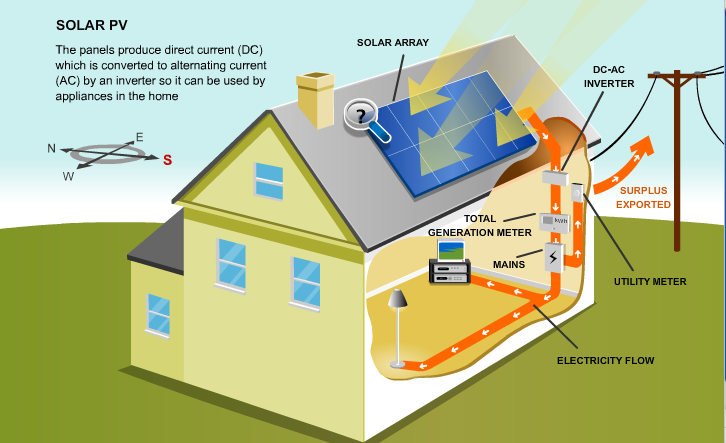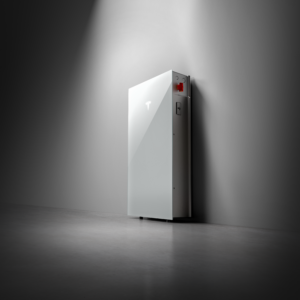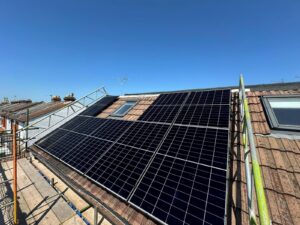
Generate free, green electricity from sunlight using Solar panel systems, also known as solar photovoltaics (PV), capture the sun’s energy using photovoltaic cells. These cells don’t need direct sunlight to work – they can still generate some electricity on a cloudy day. The cells convert the sunlight into electricity, which can be used to run household appliances and lighting.
The benefits of solar electricity
- Cut your electricity bills: sunlight is free, so once you’ve paid for the initial installation your electricity costs will be reduced.
- Sell electricity back to the grid: if your system is producing more electricity than you need, or when you can’t use it, you can sell the surplus back to the grid. Most electricity suppliers offer the Smart Export Guarantee which can pay up to 7p/KWh of electricity you export.
- Surplus electricity can also be used to charge up a battery so that you can use the energy later on when the sun has gone down, saving you more off your electricity bill. Click here for more information.
- Cut your carbon footprint: solar electricity is green, renewable energy and doesn’t release any harmful carbon dioxide] or other pollutants. A typical home solar PV system could save over a tonne of carbon dioxide per year – that’s more than 30 tonnes over its lifetime.
PV cells are made from layers of semi-conducting material, usually silicon. When light shines on the cell it creates an electric field across the layers. The stronger the sunshine, the more electricity is produced. Groups of cells are mounted together in panels or modules that can be mounted on your roof.
[accordion]
[acc_item title=”How does Solar PV work?”]PV cells are made from layers of semi-conducting material, usually silicon. When light shines on the cell it creates an electric field across the layers. The stronger the sunshine, the more electricity is produced. Groups of cells are mounted together in panels or modules that can be mounted on your roof.
The power of a PV cell is measured in kilowatts peak (kWp). That’s the rate at which it generates energy at peak performance in full direct sunlight during the summer. PV cells come in a variety of shapes and sizes. Most PV systems are made up of panels that fit on top of an existing roof.
[/acc_item]
[acc_item title=”Costs”]The average domestic solar PV system is 3.5 to 4kWp and costs around £7,000 (including VAT at 5%), with the typical cost ranging from £5,500 to £9,500.
Costs have fallen significantly over the last year and vary between products and complexity of the installation.
Other factors that affect PV installation costs are:
- The more electricity the system can generate, the more it costs but the more it could save.
- Larger systems are usually more cost-effective than smaller systems (up to 4kWp).
- PV panels are all around the same price per kWp, but PV tiles cost much more than a typical system made up of panels.
- Panels built into a roof are more expensive than those that sit on top.
The power of a PV cell is measured in kilowatts peak (kWp). That’s the rate at which it generates energy at peak performance in full direct sunlight during the summer. PV cells come in a variety of shapes and sizes. Most PV systems are made up of panels that fit on top of an existing roof.[/acc_item]
[acc_item title=”Savings”]
A 4.0kWp system can generate around 3,800 kilowatt hours of electricity a year – about three quarters of a typical household’s electricity needs. It will save over a tonne of carbon dioxide every year.
[acc_item title=”Maintenance”]Solar PV needs little maintenance – you’ll just need to keep the panels relatively clean and make sure trees don’t begin to overshadow them. In the UK panels that are tilted at 15° or more have the additional benefit of being cleaned by rainfall to ensure optimal performance. Debris is more likely to accumulate if you have ground mounted panels.
If dust, debris, snow or bird droppings are a problem they should be removed with warm water (and perhaps some washing-up liquid or something similar) and a brush or a high-pressure hose (or telescopic cleaning pole) if the panels are difficult to reach.
Always be careful if you are working above the ground or near the top of a ladder.[/acc_item]
[/accordion]



